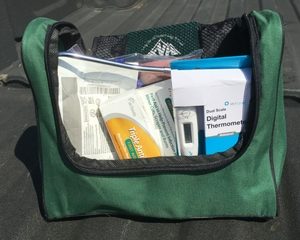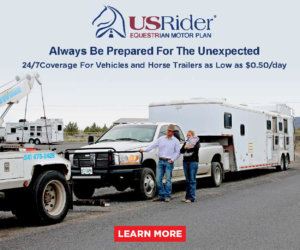A Well Equipped Kit Can Save the Day
by Dave Sauter, DVM

With over 350 breeds of horses worldwide there is enormous variety in size, shape and purpose. One thing they all have in common is that they have been bred to perform some work-related or athletic job. Their athleticism along with their naturally strong fight and flight instinct makes them susceptible to more than their fair share of health problems. Whether it’s injury or illness, having a well-equipped first aid kit on hand will help you handle the situation.
There are a few items in the first aid kit that are strictly for collecting information. Conducting a basic exam provides important information regarding your horse’s condition and this requires a few essential items:
- Stethoscope – enables you to listen to the heart to determine the heart rate. A stethoscope also enables you to listen to lung and gut sounds. Becoming familiar with what is normal will help to recognize what is abnormal. Although very expensive stethoscopes are available. Expect to pay $40–$50 or more for a good one.
- Digital thermometer – a bit of training can be very helpful, for you and your horse. Obviously, you’ll be making contact with a very sensitive area, so trust and familiarity are essential so that the horse doesn’t freak out and it can be done safely. Don’t forget to use a lubricant, like petroleum jelly.
- Weight tape – although not always accurate, if the same tape and method is used, it does provide a reasonable estimate and reveals weight change.
- Penlight – a bright narrow beam light is useful for examining eyes and to evaluate mucous membranes (MM). MM should be described by their color, moistness and capillary refill time (CRT). Color should be pink, surface moist, and CRT 1 second or less.
The next group of supplies is for treatment purposes. As you’ll see from the list, many of the items are for treating the most common equine first aid situation: injury.
- Small notebook. Keep important phone numbers, such as veterinarian, farrier and trusted equine knowledgeable friend or trainer. The notebook is also handy to record observations, such as the vital signs.
- Inventory list of what is in your kit
- Clean bucket for first aid kit only
- Roll cotton or clean rags or towels
- Antiseptic scrub, such a povidone iodine scrub or chlorhexidine scrub, for cleaning wounds. Eight or sixteen-ounce size containers are useful size.
- Clippers with number 40 blade. Clipping hair around wounds after initial cleaning is essential to properly assess wounds. Often wounds are worse than what they first appear.
- Bandage materials, including Telfa pads and large gauze sponges, preferably 4 inch by 4 inch.
- Topical antiseptics such as chlorhexidine ointment or triple antibiotic ointment. Do not use antiseptic sprays, especially BlueKote on anything other than superficial scrapes. Any wound through the skin surface should initially be covered by an ointment that will keep the surface moist and facilitate drainage.
- Topical wound fly repellent, such as Swat
- Diapers or sanitary pads can be very useful for foot bandages. Bandaging is a skill that takes practice.
- Bandage scissors with blunt tips
- Scissors with sharp tips for removing sutures. Human nail trimmers work well for this also.
- Sterile saline for irrigating wounds. Tip: to make homemade saline, add 2 teaspoons of table salt to 1 liter of boiled water, preferably deionized or distilled water.
- Latex gloves to protect you from infectious agents and vice versa, to protect the wounds you are treating for germs on your hands.
- Light sources. Flashlights and standalone lights can be very helpful.
- Rasp and nippers to pull a shoe
- Large knife to cut a rope
- Wire cutters
- Hoof boot to protect an injured foot
- Clean fly mask to protect an injured eye from sunlight, insects and wind
- Syringes and needles of various sizes
In addition, it might be helpful to have a few prescription items on hand. These might be especially important on weekends, holidays, and when traveling or visiting more remote areas. Of course, this requires working knowledge of risks and benefits of these medications. Only your veterinarian can provide you with prescription items, if indicated.
- Anti-inflammatory medication such as phenylbutazone, Banamine or Equioxx
- Antibiotics such as Uniprim or penicillin
- Eye ointment for corneal abrasions
- Tranquilizers – discuss options with your veterinarian
Keep your first aid kit clean and organized. Store it in an accessible place, safe from pets and children. Check expiration dates to replace out of date items. Also, keep a human first aid kit on hand as well!
Published in September 2016 Issue

Dave Sauter is a Minnesota native and graduated from the University of Minnesota in 1987. Following graduation he interned at Rood and Riddle Equine Hospital in Lexington, Kentucky. After this internship, he continued to work exclusively with horses for another five years in Kentucky before moving out West and joining Kulshan Veterinary Hospital in Lynden, WA. He is a member of the AAEP, AVMA and the WSVMA. For more information about Kulshan Veterinary Hospital call 360-354-5095 or email [email protected]. www.KulshanVet.com






